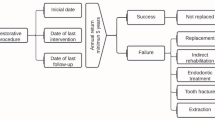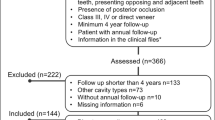Abstract
Aim
The aim of this prospective, non-interventional, multi-center, practice-based study was, firstly, to evaluate the longevity of composite build-ups in endodontically treated teeth (ETT) without post placement and, secondly, to analyze factors influencing the success of these composite build-ups.
Methodology
Each of seven general dental practitioners placed up to 50 composite build-ups without additional posts in ETT. Teeth were restricted to incisors, canines, and premolars. Several clinical data were recorded for 192 coronal restorations on ETT in 192 patients. Cox proportional hazard models were applied to analyze associations between clinical factors and time until failure.
Results
Within a follow-up period of 10 years, 167 restorations were judged as successful [mean success time, 110 (105–115) months] and 180 teeth survived [mean survival time, 114 (110–119) months]. The main failure type was fracture of the restoration (n = 15). The annual failure rate was 2.4%. In bivariate Cox regression, both factors such as number of restored tooth surfaces and adhesive were significantly associated with the failure rate. In multivariate Cox proportional hazards regression, none of the investigated factors were significantly associated with the failure rate.
Conclusion
For composite build-ups in ETT without post placement, high success rates could be found after up to 10 years of observation time. Within the limitations of the present study, none of the analyzed factors such as “tooth type” or “number of restored tooth surfaces” was a significant predictor for the failure rate.
Clinical relevance
Endodontically treated teeth can be successfully directly restored with composite build-ups even when no additional post is inserted.
Trial registration
The study was registered in the German Clinical Trials Register (DRKS-ID: DRKS00012882).
Similar content being viewed by others
References
Naumann M, Koelpin M, Beuer F, Meyer-Lueckel H (2012) 10-year survival evaluation for glass-fiber-supported postendodontic restoration: a prospective observational clinical study. J Endod 38:432–435. https://doi.org/10.1016/j.joen.2012.01.003
Naumann M, Reich S, Nothdurft FP, Beuer F, Schirrmeister JF, Dietrich T (2008) Survival of glass fiber post restorations over 5 years. Am J Dent 21:267–272
Sorensen JA, Martinoff JT (1984) Intracoronal reinforcement and coronal coverage: a study of endodontically treated teeth. J Prosthet Dent 51:780–784
Cagidiaco MC, Garcia-Godoy F, Vichi A, Grandini S, Goracci C, Ferrari M (2008) Placement of fiber prefabricated or custom made posts affects the 3-year survival of endodontically treated premolars. Am J Dent 21:179–184
Monticelli F, Grandini S, Goracci C, Ferrari M (2003) Clinical behavior of translucent-fiber posts: a 2-year prospective study. Int J Prosthodont 16:593–596
Santos AF, Meira JB, Tanaka CB, Xavier TA, Ballester RY, Lima RG, Pfeifer CS, Versluis A (2010) Can fiber posts increase root stresses and reduce fracture? J Dent Res 89:587–591. https://doi.org/10.1177/0022034510363382
Juloski J, Radovic I, Goracci C, Vulicevic ZR, Ferrari M (2012) Ferrule effect: a literature review. J Endod 38:11–19. https://doi.org/10.1016/j.joen.2011.09.024
Mannocci F, Bertelli E, Sherriff M, Watson TF, Ford TR (2002) Three-year clinical comparison of survival of endodontically treated teeth restored with either full cast coverage or with direct composite restoration. J Prosthet Dent 88:297–301
Sorrentino R, Monticelli F, Goracci C, Zarone F, Tay FR, Garcia-Godoy F, Ferrari M (2007) Effect of post-retained composite restorations and amount of coronal residual structure on the fracture resistance of endodontically-treated teeth. Am J Dent 20:269–274
Naumann M, Preuss A, Frankenberger R (2007) Reinforcement effect of adhesively luted fiber reinforced composite versus titanium posts. Dent Mater 23:138–144. https://doi.org/10.1016/j.dental.2006.01.002
Rosentritt M, Sikora M, Behr M, Handel G (2004) In vitro fracture resistance and marginal adaptation of metallic and tooth-coloured post systems. J Oral Rehabil 31:675–681. https://doi.org/10.1111/j.1365-2842.2004.01286.x
Salameh Z, Ounsi HF, Aboushelib MN, Sadig W, Ferrari M (2008) Fracture resistance and failure patterns of endodontically treated mandibular molars with and without glass fiber post in combination with a zirconia-ceramic crown. J Dent 36:513–519. https://doi.org/10.1016/j.jdent.2008.03.014
Salameh Z, Sorrentino R, Papacchini F, Ounsi HF, Tashkandi E, Goracci C, Ferrari M (2006) Fracture resistance and failure patterns of endodontically treated mandibular molars restored using resin composite with or without translucent glass fiber posts. J Endod 32:752–755. https://doi.org/10.1016/j.joen.2006.02.002
Bitter K, Noetzel J, Stamm O, Vaudt J, Meyer-Lueckel H, Neumann K, Kielbassa AM (2009) Randomized clinical trial comparing the effects of post placement on failure rate of postendodontic restorations: preliminary results of a mean period of 32 months. J Endod 35:1477–1482. https://doi.org/10.1016/j.joen.2009.07.026
Ferrari M, Cagidiaco MC, Grandini S, De Sanctis M, Goracci C (2007) Post placement affects survival of endodontically treated premolars. J Dent Res 86:729–734. https://doi.org/10.1177/154405910708600808
Assif D, Gorfil C (1994) Biomechanical considerations in restoring endodontically treated teeth. J Prosthet Dent 71:565–567
Opdam NJ, Bronkhorst EM, Loomans BA, Huysmans MC (2010) 12-year survival of composite vs. amalgam restorations. J Dent Res 89:1063–1067. https://doi.org/10.1177/0022034510376071
Hickel R, Roulet JF, Bayne S, Heintze SD, Mjor IA, Peters M, Rousson V, Randall R, Schmalz G, Tyas M, Vanherle G (2007) Recommendations for conducting controlled clinical studies of dental restorative materials. Science Committee Project 2/98—FDI World Dental Federation study design (part I) and criteria for evaluation (part II) of direct and indirect restorations including onlays and partial crowns. J Adhes Dent 9(Suppl 1):121–147
von Elm E, Altman DG, Egger M, Pocock SJ, Gotzsche PC, Vandenbroucke JP, Initiative S (2008) The Strengthening the Reporting of Observational Studies in Epidemiology (STROBE) statement: guidelines for reporting observational studies. J Clin Epidemiol 61:344–349. https://doi.org/10.1016/j.jclinepi.2007.11.008
European Society of Endodontology (2006) Quality guidelines for endodontic treatment: consensus report of the European Society of Endodontology. Int Endod J 39:921–930
Wierichs RJ, Kramer EJ, Meyer-Lueckel H (2017) Risk factors for failure in the management of cervical caries lesions. Clin Oral Investig 21:2123–2131. https://doi.org/10.1007/s00784-016-2002-1
Wierichs RJ, Kramer EJ, Meyer-Lueckel H (2018) Risk factors for failure of class V restorations of carious cervical lesions in general dental practices. J Dent. https://doi.org/10.1016/j.jdent.2018.07.013
Sterzenbach G, Franke A, Naumann M (2012) Rigid versus flexible dentine-like endodontic posts—clinical testing of a biomechanical concept: seven-year results of a randomized controlled clinical pilot trial on endodontically treated abutment teeth with severe hard tissue loss. J Endod 38:1557–1563. https://doi.org/10.1016/j.joen.2012.08.015
Signore A, Benedicenti S, Kaitsas V, Barone M, Angiero F, Ravera G (2009) Long-term survival of endodontically treated, maxillary anterior teeth restored with either tapered or parallel-sided glass-fiber posts and full-ceramic crown coverage. J Dent 37:115–121. https://doi.org/10.1016/j.jdent.2008.10.007
Bitter K, Kielbassa AM (2007) Post-endodontic restorations with adhesively luted fiber-reinforced composite post systems: a review. Am J Dent 20:353–360
Naumann M, Blankenstein F, Dietrich T (2005) Survival of glass fibre reinforced composite post restorations after 2 years-an observational clinical study. J Dent 33:305–312. https://doi.org/10.1016/j.jdent.2004.09.005
Naumann M, Blankenstein F, Kiessling S, Dietrich T (2005) Risk factors for failure of glass fiber-reinforced composite post restorations: a prospective observational clinical study. Eur J Oral Sci 113:519–524. https://doi.org/10.1111/j.1600-0722.2005.00257.x
Torbjorner A, Fransson B (2004) A literature review on the prosthetic treatment of structurally compromised teeth. Int J Prosthodont 17:369–376
Torbjorner A, Fransson B (2004) Biomechanical aspects of prosthetic treatment of structurally compromised teeth. Int J Prosthodont 17:135–141
Assif D, Oren E, Marshak BL, Aviv I (1989) Photoelastic analysis of stress transfer by endodontically treated teeth to the supporting structure using different restorative techniques. J Prosthet Dent 61:535–543
Stankiewicz NR, Wilson PR (2002) The ferrule effect: a literature review. Int Endod J 35:575–581
Acknowledgements
The authors are grateful to the dental practitioners who treated the patients and provided their data.
Funding
This study was funded by the authors and their institution.
Author information
Authors and Affiliations
Contributions
E.K. and the network Arbeitskreis Zahnärztliche Therapie designed and planned the study; R.J.W., E.K., T.G.W., M.N., and H.M.-L. designed the study evaluation; E.K. provided the patient files; R.J.W. and T.G.W. performed the statistical analysis; R.J.W. and H.M.-L. wrote the manuscript; and E.K., T.G.W., and M.N. revised the manuscript.
Corresponding author
Ethics declarations
Conflict of interest
The authors declare that they have no conflicts of interests.
Ethical approval
This study was a prospective, non-interventional, multi-center, clinical study without the need for local review board approval according to ethical committee of the Medial Chamber of Lower Saxony. This study conforms to the STROBE guideline for cohort studies [19]. The study has been registered in the German Clinical Trials Register (DRKS-ID: DRKS00012882).
Informed consent
For this type of study, formal consent is not required.
Rights and permissions
About this article
Cite this article
Wierichs, R.J., Kramer, E.J., Wolf, T.G. et al. Longevity of composite build-ups without posts—10-year results of a practice-based study. Clin Oral Invest 23, 1435–1442 (2019). https://doi.org/10.1007/s00784-018-2565-0
Received:
Accepted:
Published:
Issue Date:
DOI: https://doi.org/10.1007/s00784-018-2565-0




